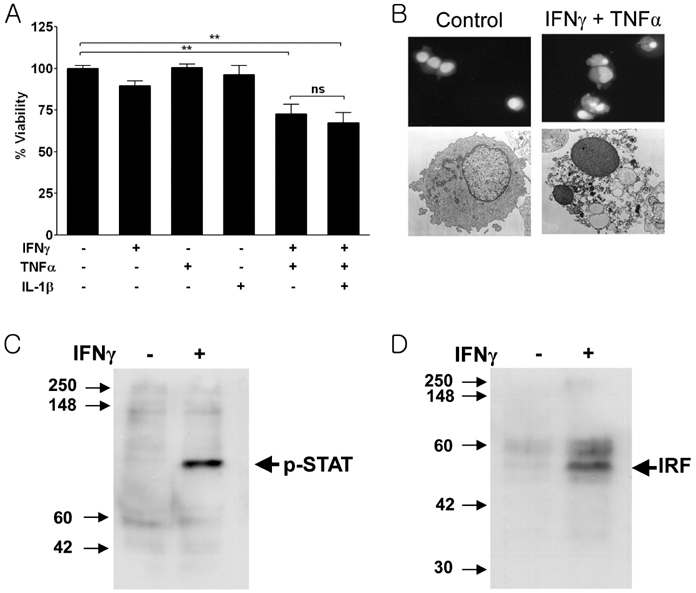Immune Netw.
2012 Jun;12(3):113-117. 10.4110/in.2012.12.3.113.
Apoptosis of Human Islet Cells by Cytokines
- Affiliations
-
- 1Department of Medicine, Samsung Medical Center, Sungkyunkwan University School of Medicine, Seoul 135-710, Korea. mslee0923@skku.edu
- 2New Experimental Therapeutics Branch, Division of Convergence Technology, National Cancer Center, Goyang 410-769, Korea.
- 3Department of Pharmacology, Brain Science and Engineering Institute, CMRI, Kyungpook National University School of Medicine, Daegu 700-422, Korea.
- 4Molecular Imaging & Therapy Branch, Division of Convergence Technology, National Cancer Center, Goyang 410-769, Korea.
- KMID: 2168009
- DOI: http://doi.org/10.4110/in.2012.12.3.113
Abstract
- FasL, perforin, TNFalpha, IL-1 and NO have been considered as effector molecule(s) leading to beta-cell death in autoimmune diabetes. However, the real culprit(s) of beta-cell destruction have long been elusive despite intense investigation. Previously we have suggested IFNgamma/TNFalpha synergism as the final effector molecules in autoimmune diabetes of NOD mice. A combination of IFNgamma and TNFalpha but neither cytokine alone, induced classical caspase-dependent apoptosis in murine insulinoma and pancreatic islet cells. IFNgamma treatment conferred susceptibility to TNFalpha-induced apoptosis on otherwise resistant murine insulinoma cells by STAT1 activation followed by IRF-1 induction. Here we report that IFNgamma/TNFalpha synergism induces apoptosis of human pancreatic islet cells. We also observed STAT1 activation followed by IRF-1 induction by IFNgamma treatment in human islet cells. Taken together, we suggest that IFNgamma/TNFalpha synergism could be involved in human islet cell death in type 1 diabetes, similar to murine type 1 diabetes.
Keyword
MeSH Terms
Figure
Reference
-
1. Kim S, Kim HS, Chung KW, Oh SH, Yun JW, Im SH, Lee MK, Kim KW, Lee MS. Essential role for signal transducer and activator of transcription-1 in pancreatic beta-cell death and autoimmune type 1 diabetes of nonobese diabetic mice. Diabetes. 2007. 56:2561–2568.
Article2. Suk K, Kim S, Kim YH, Kim KA, Chang I, Yagita H, Shong M, Lee MS. IFN-gamma/TNF-alpha synergism as the final effector in autoimmune diabetes: a key role for STAT1/IFN regulatory factor-1 pathway in pancreatic beta cell death. J Immunol. 2001. 166:4481–4489.
Article3. Kim HS, Han MS, Chung KW, Kim S, Kim E, Kim MJ, Jang E, Lee HA, Youn J, Akira S, Lee MS. TLR2 as a link between β-cell injury and initiation of autoimmune diabetes. Immunity. 2007. 27:321–333.
Article4. Turley S, Poirot L, Hattori M, Benoist C, Mathis D. Physiological beta cell death triggers priming of self-reactive T cells by dendritic cells in a type-1 diabetes model. J Exp Med. 2003. 198:1527–1537.
Article5. Wicker LS, Miller BJ, Mullen Y. Transfer of autoimmune diabetes mellitus with splenocytes from nonobese diabetic (NOD) mice. Diabetes. 1986. 35:855–860.
Article6. Wang Y, Pontesilli O, Gill RG, La Rosa FG, Lafferty KJ. The role of CD4+ and CD8+ T cells in the destruction of islet grafts by spontaneously diabetic mice. Proc Natl Acad Sci U S A. 1991. 88:527–531.
Article7. Katz JD, Benoist C, Mathis D. T helper cell subsets in insulin-dependent diabetes. Science. 1995. 268:1185–1188.
Article8. Kurrer MO, Pakala SV, Hanson HL, Katz JD. Beta cell apoptosis in T cell-mediated autoimmune diabetes. Proc Natl Acad Sci U S A. 1997. 94:213–218.9. Kim YH, Kim S, Kim KA, Yagita H, Kayagaki N, Kim KW, Lee MS. Apoptosis of pancreatic beta-cells detected in accelerated diabetes of NOD mice: no role of Fas-Fas ligand interaction in autoimmune diabetes. Eur J Immunol. 1999. 29:455–465.
Article10. Amrani A, Verdaguer J, Anderson B, Utsugi T, Bou S, Santamaria P. Perforin-independent beta-cell destruction by diabetogenic CD8(+) T lymphocytes in transgenic nonobese diabetic mice. J Clin Invest. 1999. 103:1201–1209.
Article11. Kim S, Kim KA, Hwang DY, Lee TH, Kayagaki N, Yagita H, Lee MS. Inhibition of autoimmune diabetes by Fas ligand: the paradox is solved. J Immunol. 2000. 164:2931–2936.
Article12. Ricordi C, Lacy PE, Finke EH, Olack BJ, Scharp DW. Automated method for isolation of human pancreatic islets. Diabetes. 1988. 37:413–420.
Article13. Rabinovitch A, Sumoski W, Rajotte RV, Warnock GL. Cytotoxic effects of cytokines on human pancreatic islet cells in monolayer culture. J Clin Endocrinol Metab. 1990. 71:152–156.
Article14. Rabinovitch A, Suarez-Pinzon WL, Strynadka K, Schulz R, Lakey JR, Warnock GL, Rajotte RV. Human pancreatic islet beta-cell destruction by cytokines is independent of nitric oxide production. J Clin Endocrinol Metab. 1994. 79:1058–1062.
Article15. Delaney CA, Pavlovic D, Hoorens A, Pipeleers DG, Eizirik DL. Cytokines induce deoxyribonucleic acid strand breaks and apoptosis in human pancreatic islet cells. Endocrinology. 1997. 138:2610–2614.
Article16. Marselli L, Dotta F, Piro S, Santangelo C, Masini M, Lupi R, Realacci M, del Guerra S, Mosca F, Boggi U, Purrello F, Navalesi R, Marchetti P. Th2 cytokines have a partial, direct protective effect on the function and survival of isolated human islets exposed to combined proinflammatory and Th1 cytokines. J Clin Endocrinol Metab. 2001. 86:4974–4978.
Article17. Suk K, Chang I, Kim YH, Kim S, Kim JY, Kim H, Lee MS. Interferon gamma (IFNgamma) and tumor necrosis factor alpha synergism in ME-180 cervical cancer cell apoptosis and necrosis. IFNgamma inhibits cytoprotective NF-kappa B through STAT1/IRF-1 pathways. J Biol Chem. 2001. 276:13153–13159.
Article18. Barthson J, Germano CM, Moore F, Maida A, Drucker DJ, Marchetti P, Gysemans C, Mathieu C, Nuñez G, Jurisicova A, Eizirik DL, Gurzov EN. Cytokines tumor necrosis factor-α and interferon-γ induce pancreatic β-cell apoptosis through STAT1-mediated Bim protein activation. J Biol Chem. 2011. 286:39632–39643.
Article
- Full Text Links
- Actions
-
Cited
- CITED
-
- Close
- Share
- Similar articles
-
- Alpha-Melanocyte Stimulating Hormone Protects Pancreatic Islet Dysfunction by Peripheral Blood Mononuclear Cells in vitro
- Effects of Insulin and Vitamin E on the Apoptosis of Pancreatic Islet Cells in Multiple Low dose Streptozotocin Induced Diabetic (LDSD) Mice
- Pathogenesis of Type 1 Diabetes
- Differentiation and Apoptosis of the Erythroid, Myeloid and Megakaryocytic Lineage Cells in vitro Culture of Cord Blood CD34+ Cells Using Various Cytokines
- Effects of Cycloheximide and Dexamethasone on Fas - Mediated Apopthsis in Primary Human Astrocytes


